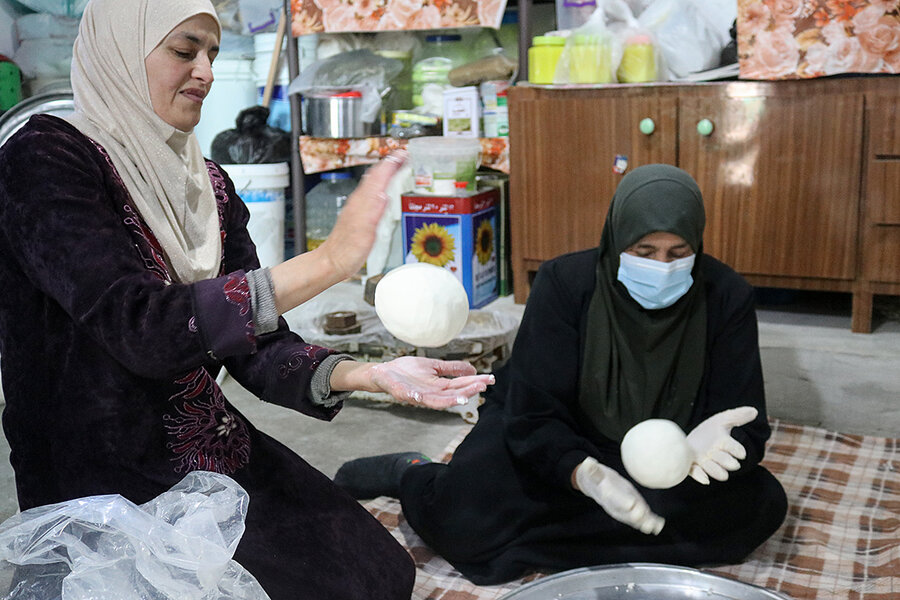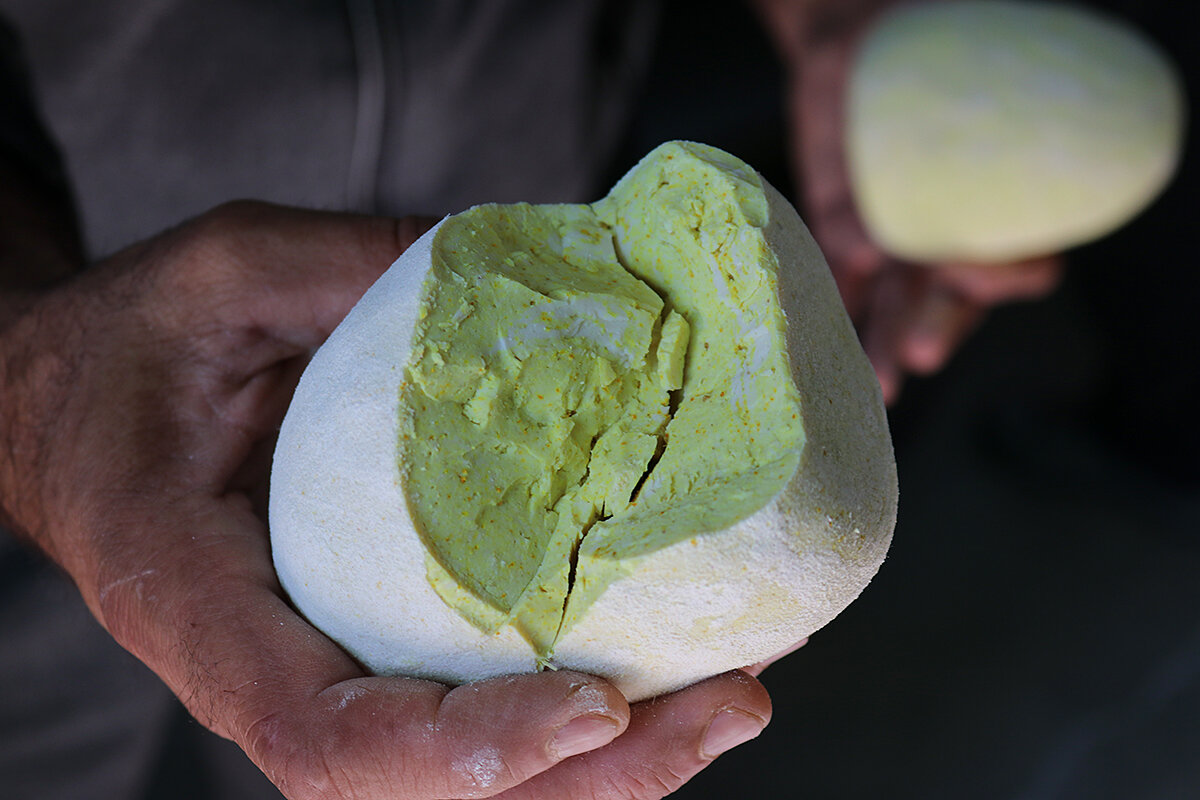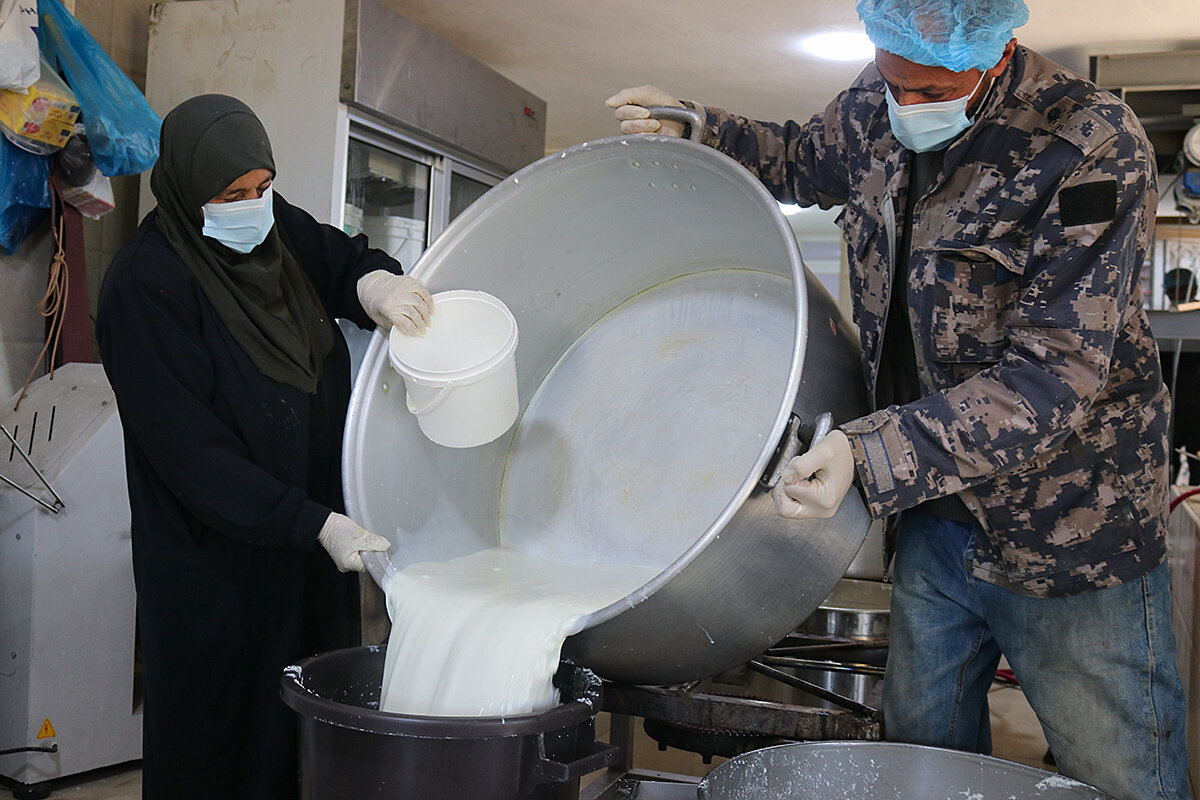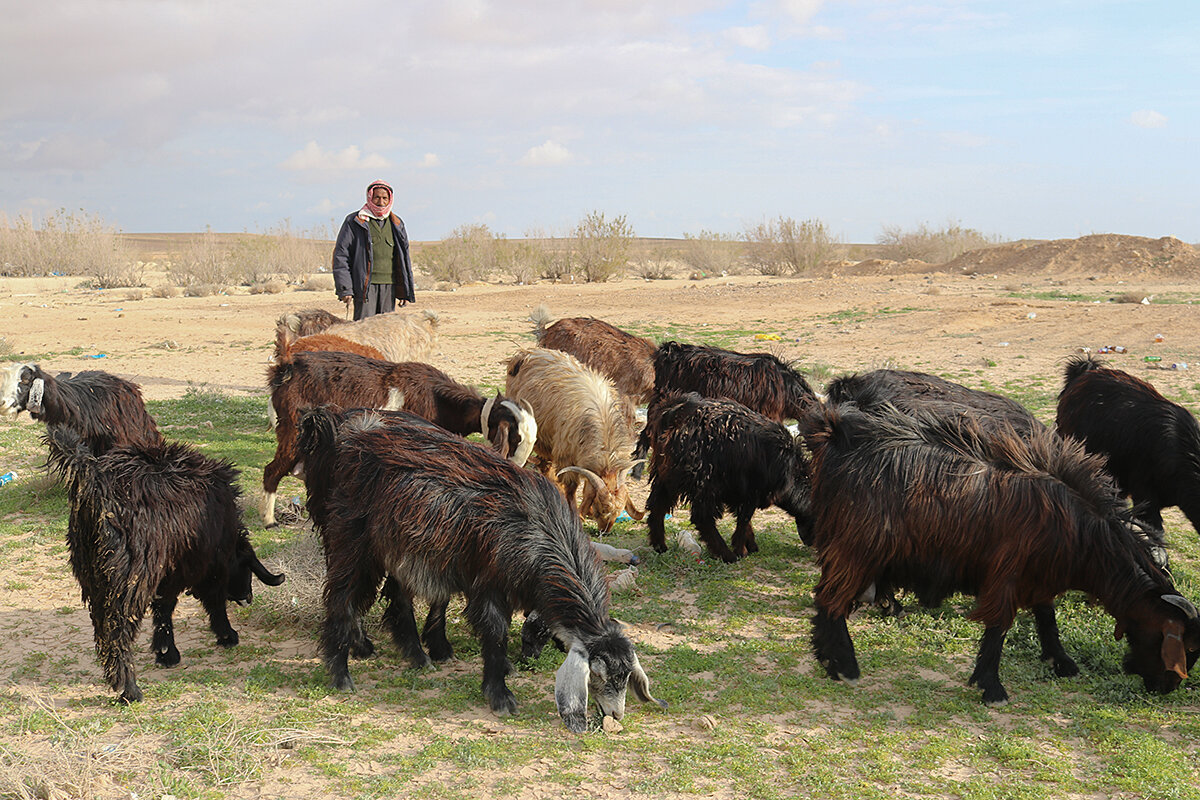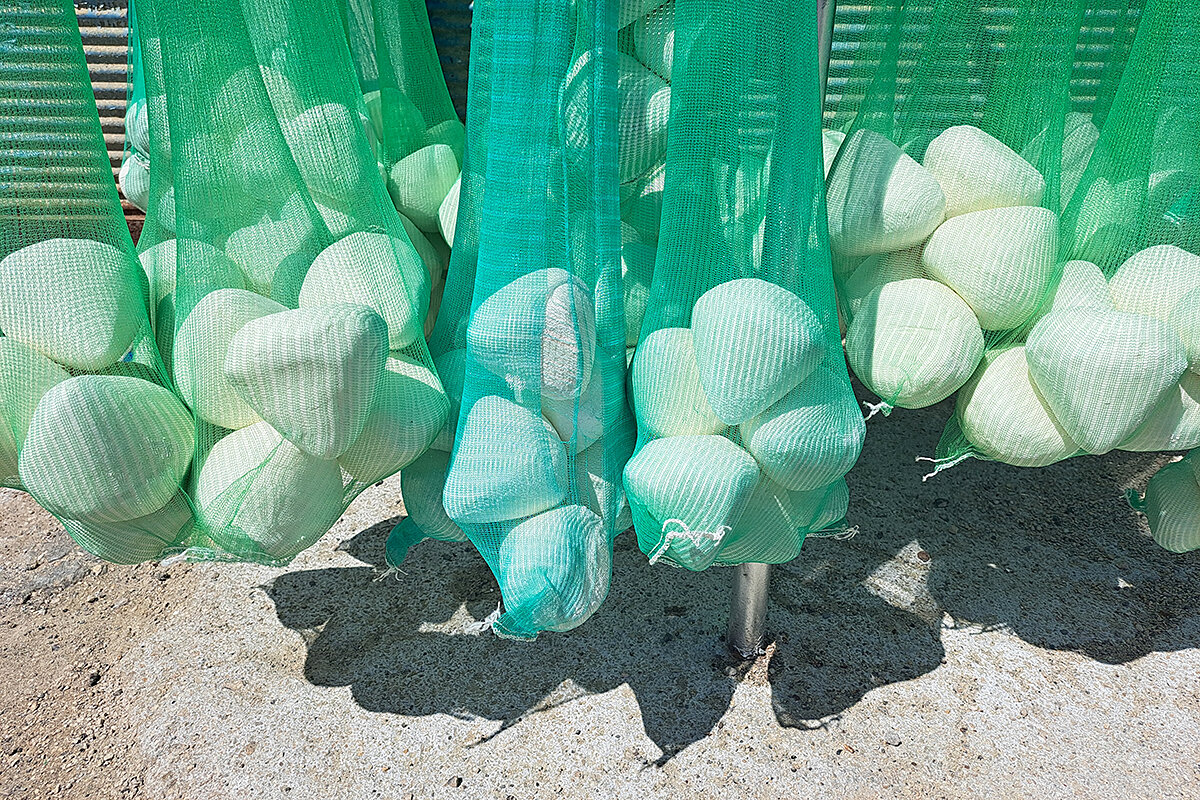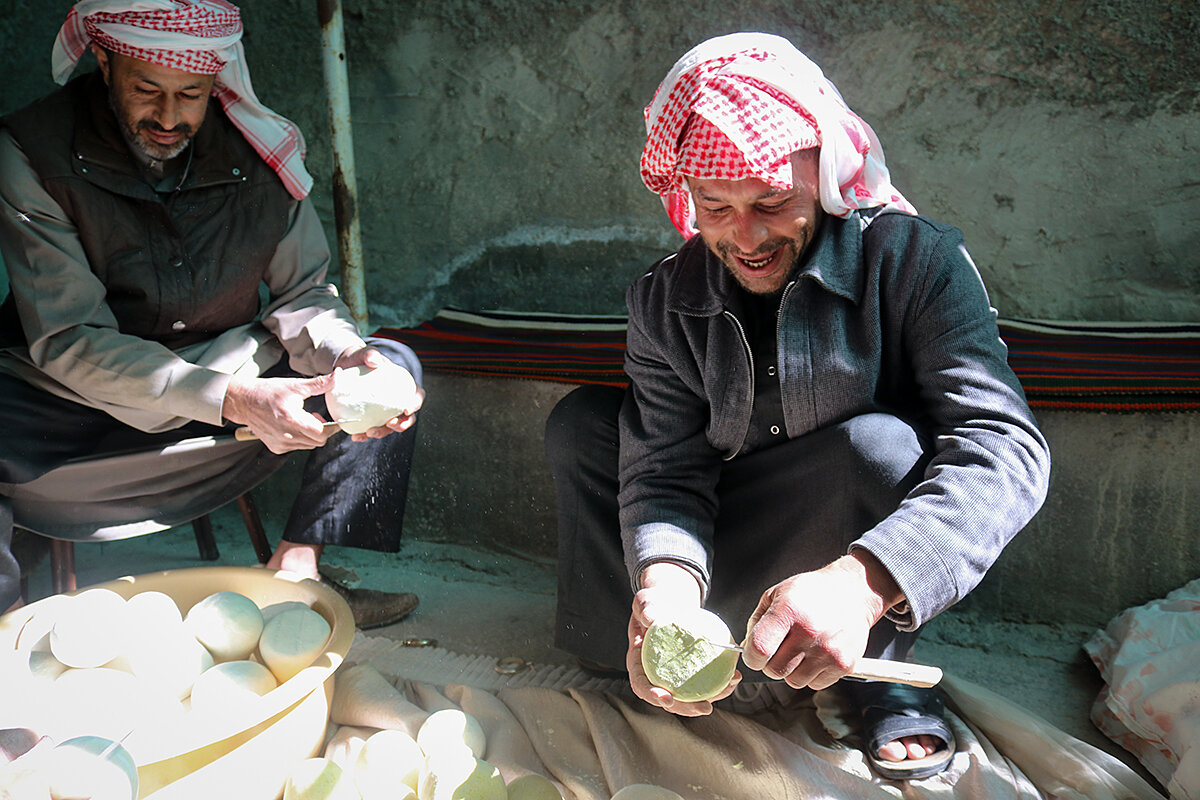The secret behind Jordan’s national dish? A ‘yogurt that unites.’
Loading...
| Karak, Jordan
Shoulders aching, Um Hazem holds up in her hands a sample of the day’s labor, a fist-sized nugget of Jordan’s prized “white gold.”
“It may only be yogurt, but it is yogurt that unites us,” says the grandmother.
Sour, salty, filling, and soothing, the yogurt is the key ingredient in mansaf, a UNESCO-recognized dish that is a culinary balm for the souls of Jordanians, enjoying an undisputed status as a national symbol.
Why We Wrote This
A story focused onFood unites. It’s universal. But in Jordan, springtime production of the key ingredient that gives a UNESCO-recognized, ancient national dish its distinctive flavor requires an extra, all-hands-on-deck level of cooperation.
While the ancient dish is prized for its taste, it represents an important meeting point for the people of this historic Middle East crossroads. Uniting both nomadic Bedouins and sedentary villagers, it passes on generational lessons in sharing, cooperation, and respect with every serving.
At weddings and funerals, high school graduations and royal receptions, and even on lazy Fridays, the diverse peoples who call Jordan home gather around large platters of mansaf year-round.
A mound of rice or cracked wheat topped with chunks of falling-off-the-bone lamb and drizzled with a hot yogurt sauce, this three-ingredient meal has been a staple in the lands east of the Jordan River and northwest of the Arabian Peninsula for more than 2,000 years.
Ultimate team effort
The dish is a product of cooperation and coexistence between Bedouin shepherds and village farmers: The cracked wheat is from farming villages, the yogurt from the Bedouin herders’ goats and sheep.
Producing mansaf’s key ingredient is the ultimate team effort in Karak, a southern Jordanian region famous for jameed, the dehydrated sun-dried yogurt used to make the sour and salty sauce Jordanians can’t get enough of.
In the Karak village of Zahoum, the Malahmeh family works 16 hours a day, seven days a week while the spring milk season lasts.
In a rented industrial kitchen, aproned family members flutter from one giant stainless steel vat to another to churn and strain yogurt, a thicker version known as labneh, butter, and finally jameed.
Each step requires precision. One degree off on a burner or a single second without a stir can ruin an entire batch of 60 kilograms of milk, wasting a day’s work.
“Milk season means nonstop work for the whole family until June,” Hossam Malahmeh says as his wife readies a large mixer. “But all of Jordan is counting on us.”
As family members shift vats of milk through various stages of production, shepherds from the desert come knocking on the door with more churns and buckets of minutes-old sheep’s milk.
Fresh off a milk delivery, shepherd Abu Odeh marvels at the kitchen as he sips a glass of tea – a short break before he returns to his 200 sheep.
“The times and technology have developed over the centuries, but the rhythm of our lives is the same,” says Abu Odeh, whose herd’s milk has put two children through university. “Spring is our season, and jameed and mansaf are our livelihoods.”
“No mine and yours”
Abu Odeh and other residents of the region say their jameed’s prized flavor is down to the diverse geography of Karak and much of southern and central Jordan: rolling green hills that suddenly thin out into desert plains.
The fertile hills and arid desert offer a variety of shrubs and grasses throughout the year and different climates for shepherds’ flocks, which are rotated according to grazing arrangements between Bedouins and villagers that date back centuries.
“You need both desert and farms, village dwellers and Bedouins to make proper jameed and proper mansaf,” says Abu Odeh.
For the final laborious step, Mr. Malahmeh’s mother, Um Hazem, requires all the women of the family to roll up their sleeves and pitch in: daughters, daughters-in-law, nieces, even her husband’s second wife.
Sitting around a giant tray of strained and compressed yogurt, each woman scoops a handful and then starts to clap, slap, shape, and toss the product into fist-size balls to be dried and sold.
Their shoulders and arms ache from the previous night’s session, but they keep going to get the day’s batch of 400 balls done.
“There is no mine and yours, your job, my job,” says Um Hazem. “It’s jameed season and everyone automatically works together.”
Outside, the Malahmeh men grunt in agreement as they crouch down and to scrape off salt crystals from dried jameed ready for sale.
Two miles north, Zaal Kawalit runs churning machinery he brought to Jordan from Turkey in 1992, revolutionizing the production of an ingredient that was then still being made by grandmothers furiously shaking yogurt in leather bags in the sun.
“We had to modernize jameed production to ensure mansaf’s survival in the 21st century,” he says as he welcomes an impeccably dressed shepherd into his dairy factory. “Otherwise jameed and the important lessons of mansaf would have died out.”
Etiquette and values
Late last year UNESCO inscribed mansaf on its Intangible Cultural Heritage list, highlighting the dish as an “important and well-known symbol that evokes a deep sense of identity and social cohesion” that “is associated with the agro-pastoral lifestyle” in Jordan.
“Mansaf is not just a food. It is a ceremony,” explains Nayef Nawaiseh, a cultural historian in Karak who helped compile mansaf’s UNESCO heritage bid. “The goal is not to fill the stomach, but to honor guests and to gather people around.”
“The etiquette, preparation, and rules are what make the dish mansaf. These accepted rules are passed on from generation to generation; they embody the social values that make up our identity as Jordanians,” says Mr. Nawaiseh.
The cooperation required to make mansaf extends from communities to within the household, encouraging a gender parity, of sorts, in the kitchen.
Traditionally, in a practice still carried out in some Bedouin villages today, men prepare the meat and yogurt over an open fire while in a separate tent women cook the cracked wheat and shrak bread – the final dish becoming equal part the efforts of husband and wife.
One of the first lessons of mansaf is how to share: The dish is served on a large circular communal platter around which up to 13 guests sit or stand.
With one hand, each person scoops cracked wheat or rice, meat, and yogurt into a neat line in front of them – never straying right or left, taking food from their neighbor’s portion, nor reaching across to the other side of the dish.
After the 13 guests get a taste of mansaf, another 13 diners – often from the host family – then come and eat from the same platter, while the host distributes more meat and pours out splashes of piping hot yogurt for each guest.
In Jordan’s tribal culture, mansaf gathers the entire clan and neighbors, no matter any personal disagreements – the meal often acting as a forum to mediate disputes, a culinary approach to conflict resolution.
“The ceremony of mansaf teaches each generation the importance of community, solidarity, how to sit and converse and listen to others with respect and in a calm and dignified manner,” says Mr. Nawaiseh. “It is not just food to gulp down. It is community.”




